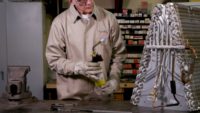Advancing Prefabrication 2022 takes place April 26-29 in Phoenix, Arizona. Harris’ CEO Michel Michno is speaking on how his group's approach to prefabrication is improving productivity and safety at jobsites across the country. Here is a Question and Answer session with Michno from the event's website:
What are the biggest external challenges you face today when it comes to optimizing prefabrication at Harris? And, how do we overcome these challenges?
Construction remains a fragmented industry. Projects involve a multitude of contracts and subcontracts. These contracts are usually procured independently with different incentives that align not necessarily with the project objectives and priorities.
Maximizing prefabrication opportunities requires early collaboration and teamwork. It only takes one entity to derail the process. Providing clarity and demanding alignment must start at the top. The leadership and vision for the project, from the earliest stages, must include prefabrication. When owners and developers provide this vision, making sure that the organizational and contractual structure of the project is consistent with their priorities and aligning incentives with the project goals, the construction team stands a better chance to maximize prefabrication.
 Some forms of contracts such as IPD and P3 (more common in Europe) are examples of contractual relationships that can help.
Some forms of contracts such as IPD and P3 (more common in Europe) are examples of contractual relationships that can help.
What are the biggest challenges you are facing internally at Harris?
The biggest challenge is securing buy-in for prefabrication. It starts with convincing business units’ leadership and must continue with project leadership. The obvious benefits associated with prefabrication of safer, better, faster, and cheaper require new processes or existing processes happening at different times. Budget and resource allocations are also different from traditional execution. It is crucial to understand the organization’s decision-making process, especially at the project level, and how it needs to change to optimize prefabrication.
The company’s leadership must provide the proper framework and incentives for the project team to invest time and money upfront in design, BIM, budgeting, and planning. Changing the decision making process will face resistance in any case. However, it will be impossible if project leadership resources continue to be estimated, planned, and budgeted as they were in the past.
Change management is challenging, especially as we have a successful stick-built construction history. Our strong field crew, field leadership, and project teams have accomplished great results and may not see the reason for the change. It may appear easier to stick to tried and tested methods in the short term, but long-term success will rely on innovation and change. Changing these processes is a multi-year initiative.
At Advancing Prefabrication 2022, you’re discussing optimizing organizational structure to integrate and enable more advance IC? How have you managed to do this at Harris?
A couple of years ago, we started mapping and optimizing our project management processes. Our transition to a more advanced prefab meant rebuilding our processes and retraining our team. We built our online training program. We made it available to the entire organization focusing on our Project Managers and operational leadership.
Our processes not only focused on prefabrication but also on early decision-making and planning. Early decision-making is how we maximize prefab: it brings the right people together at the right time to determine what is best for the project.
Now, we are implementing a new ERP. We are automating the processes we mapped and trained. We are and will get better data; it is exciting! Our progress is impressive, but this is a long process. We are currently at the stage of reinforcement. We work with our teams to ensure that our practice matches our goals. We are also planning our next steps toward digital transformation and industrialized construction.
We are excited to share our thoughts on our journey at the conference!
What are your biggest learnings that you know now regarding prefab that you with you had known at the start of your journey?
Detailed planning is critical! Success depends on matching the right plan with the appropriate activities and measurements. Using the correct cost codes and units of measure for the project setup significantly increases the odds of adequately managing activities. It sounds relatively simple and maybe even boring, but finding too late about inefficiencies or deviations results in considerable cost overruns and delays.
The challenge only increases when prefabrication comes into play. We do not have 25 years of prefab data. We have vast databases and project history that are now irrelevant. The front end of projects requires more investment with our new processes, and estimates and budgets must now match new tasks and resources. It is a firmwide transformation with a less extensive history to rely on. Aligning the units of measure and quantities with the plan reduces risk.
Where do you see the industry heading?
Projects continue to grow in size and sophistication, and we will see more and more exceptional examples of prefabrication and modular construction, but we cannot ignore smaller projects. They represent a significant portion of the industry. Smaller projects require quick execution, which may require process simplification, but we should pursue maximum prefabrication regardless of project size. Processes are critical, but not as much as culture. Progress will come from constantly challenging ourselves to maximize prefabrication.



.jpg?height=200&t=1675271241&width=200)
